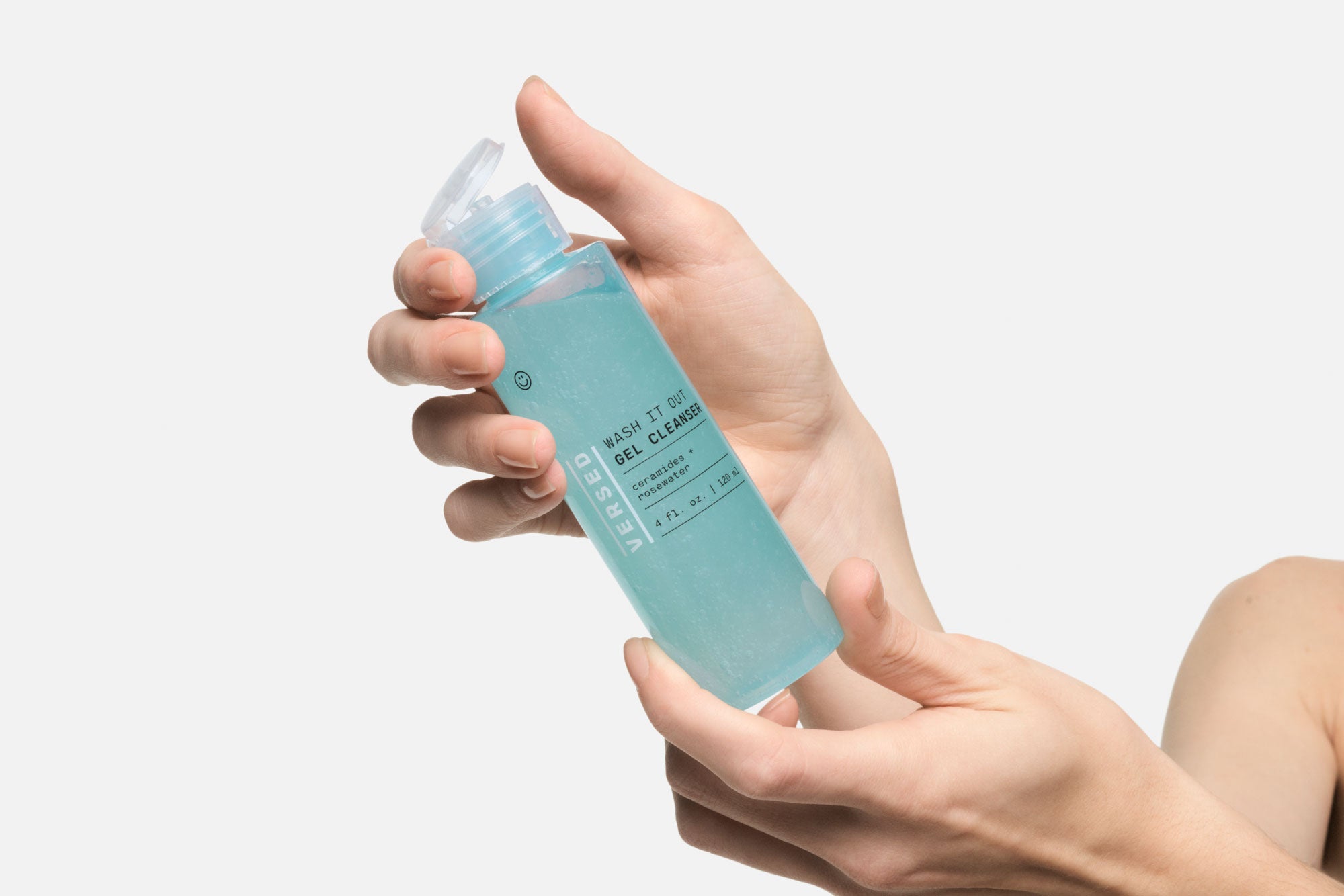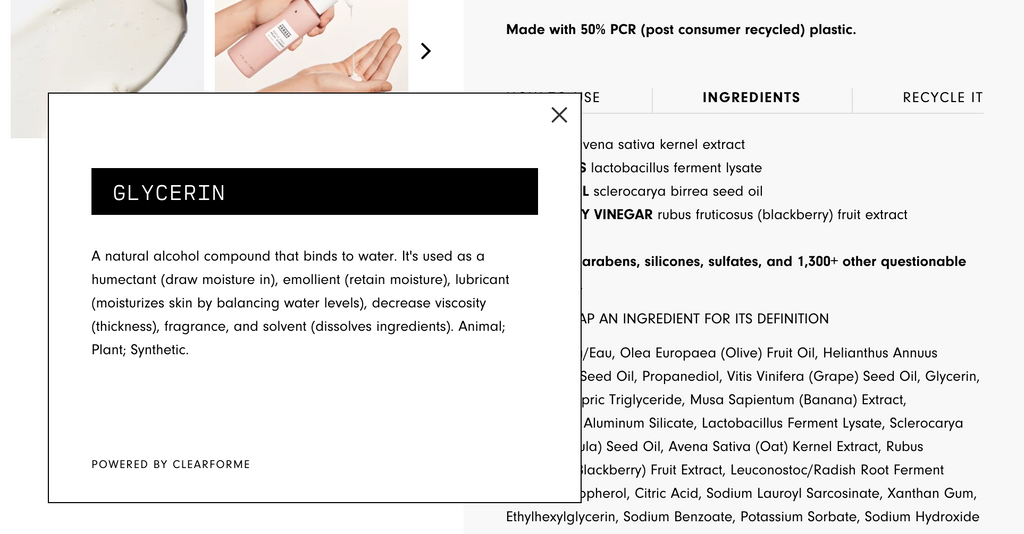
What an Ingredient Label Can Tell Us (And What It Can’t)
If you want to be a more informed skincare shopper, the first step you might take is to read your skincare products’ ingredient lists. The only problem with that is ingredient labels are hard to read. Not just because most lists look like intricate codes that are difficult to decipher, but also because the skincare ingredients listed only tell part of the story when it comes to how a product works and whether its formula is beneficial to your skin or not.
Enter: Our complete guide to reading—and actually understanding—ingredient labels. Let’s break down what these lists can (and can’t) tell you, plus some questionable ingredients you may want to consider avoiding.
What Ingredient Lists Tell Us:
What’s in a ProductFirst things first: Ingredient lists—or the INCI, which stands for International Nomenclature of Cosmetic Ingredients—can be long and, frankly, intimidating. But for the most part, there’s no need to be alarmed by scary-sounding, difficult-to-pronounce ingredients. Labels typically list ingredients by their formal, scientific names but oftentimes, it’s just a fancier way of saying something you’re already familiar with. Sodium ascorbyl phosphate, for example, is just a formal name for vitamin C. To help clear up some of this confusion, we provide the more common translation of all our active ingredients on our product detail pages. For example: Here’s Gentle Cycle’s Ingredients tab which lists the active ingredients and their common names:

You can also grab easy-to-understand definitions of everything we use in our products by scrolling further down and hovering over any ingredient. Or, simply search our Ingredient Glossary.
Which Ingredients Have the Highest (and Lowest) Concentration
Just like nutrition labels, ingredients are listed in descending order of concentration. “The highest percentages are always listed first,” says esthetician Kerry Benjamin. It’s normal to see water up top because active ingredients need a base. “Typically, the preservatives are listed last, being the smallest percentage of the total formula,” she explains. But don’t forget: Just because an ingredient is lower on the list doesn’t mean it’s any less effective.
The descending “rule” becomes a bit fuzzy, because ingredients present below 1% can be listed in any order and an ingredient list doesn’t tell you where that 1% line is (Cosmetic Formulator Annalisa Cantatore and Mixed Makeup Founder Susan Yara explain it well). And remember many ingredients are effective at levels below 1%, like retinol, which can be effective at 0.01%. “You can have two different products that have a lot of the same ingredients and one of those products have those ingredients in the top five and the other product has those same ingredients listed somewhere else throughout the ingredient list. What you don’t know is how much of each of those ingredients the product actually has”, Yara explains. “The other product might have a higher percentage of all of those active ingredients even though it doesn’t seem to look like it than the product that has them in the first five ingredients.”
Most ingredient labels won’t tell you exactly what % of an ingredient the formula contains unless it’s OTC and classified by the FDA as a drug (for example, Keep the Peace is labeled as containing 1.5% salicylic acid). While that may sound concerning, keep in mind that cosmetic chemists know what level of concentration each ingredient should safely be at so they can work their magic without irritating your complexion. This concept applies to the pH of skincare, too.
What Ingredients Labels Can’t Tell Us
How a Product Was MadeThis is a big one. Anyone who has ever followed a recipe knows there’s more to a formula than just mixing ingredients together. That’s what makes a formula’s ‘secret sauce’ so, well, secret. How ingredients are mixed together matters; change up some factors, like temperature, and you may end up with two completely different products. What the packaging can sometimes tell you, however, is whether a formula was tested on animals. Look for the Leaping Bunny symbol when shopping for cruelty-free cosmetics (all Versed products are Leaping Bunny certified).
How Ingredients Interact
On top of that, some ingredients are added to enhance another ingredient’s efficacy (that’s one of the reasons we included moringa seed extract in our Guards Up sunscreen—this antioxidant boosts the effectiveness of SPF’s ability to protect skin and fend off damage). On the other hand, some ingredients are added to soften more powerful ones, creating a more mild formula. Others are simply preservatives that protect your product from degradation and bacteria growth (more on that down below).
Whether an ingredient is extracted from a plant or made in a lab, its source will probably not be found on an ingredient list. That may require some digging on the shopper’s end to ensure their skin picks are sustainably sourced and ethically made. For example, some plants like bakuchiol—which is a natural alternative to retinol—can become endangered when they are overharvested. That’s why the bakuchiol used in our Gentle Retinol Serum is CITES (Convention on International Trade in Endangered Species of Wild Fauna and Flora) certified, meaning its use doesn't negatively impact the plant species' survival. All Versed products are 100% vegan and use FSC-certified paper packaging. We also offset any greenhouse gas emissions associated with a product’s lifecycle (including shipping).
What to Avoid
While it’s probably not feasible to go over every single ingredient in every single skincare product (at least not in one article), there are some red flags to look out for (and rest assured you won’t find any of these in Versed products).
Parabens: “Paraben-free skincare” is a phrase you’ve likely seen a lot as of late. That’s because parabens are widely acknowledged as being harmful. But let’s back up first. Parabens make up a category of preservatives. The purpose of preservatives is to do just that—preserve a product’s freshness and potency. “The common preservatives used [in skincare] are phenoxyethanol and ethylhexylglycerin,” Benjamin says. Vitamin E, found in our Antioxidant Oil-Serum, is also a great natural preservative.
The only kinds of preservatives that Benjamin recommends straying from are parabens, which may have prefixes such as methyl, ethyl, propyl, or butyl. “These are preservatives that some studies say can cause cancer, which is now a widespread belief, and most well-known reputable brands have moved away from parabens.”
Formaldehyde: This is a specific type of preservative that is found in certain skincare products. According to the Environmental Working Group, it’s a possible carcinogen. Notably, it won’t always be listed as “formaldehyde.” It can also go by such names as imidazolidinyl urea, diazolidinyl urea, quaternium-15, bronopol, and 5-bromo-5-nitro-1, d-dioxane.
Sulfates: These are widely regarded as one of the most aggressive ingredients in beauty products. This ingredient category, which includes sodium lauryl sulfate, ammonium lauryl sulfate, and sodium laureth sulfate, are cleansing agents that can strip and irritate the skin.
Fragrance: “These can be very irritating and cause a reaction and inflammation,” Benjamin says. When you see “fragrance” on an ingredient label there could be dozen, hundreds, or even thousands of chemicals making up that one ingredient. That’s because brands are not required to disclose fragrance ingredients because they’re considered trade secrets.
Phthalates: These are ingredients added to skincare products to moisturize and soften the skin as well as dissolve certain ingredients. The most common one is called DEP (diethyl phthalate), and it’s widely acknowledged as having the potential to damage certain organs in the body.
Silicone: This ingredient is added to skincare products in order to smooth the texture of the skin. One of the most common being dimethicone. It forms a barrier across the skin that can trap moisture, but can also lead to congested pores and breakouts. While not necessarily harmful, it’s not ideal for people with oily or acne-prone skin.
Speaking of scary-sounding ingredients, check out this list of ingredients that sound intimidating but are actually quite beneficial.



